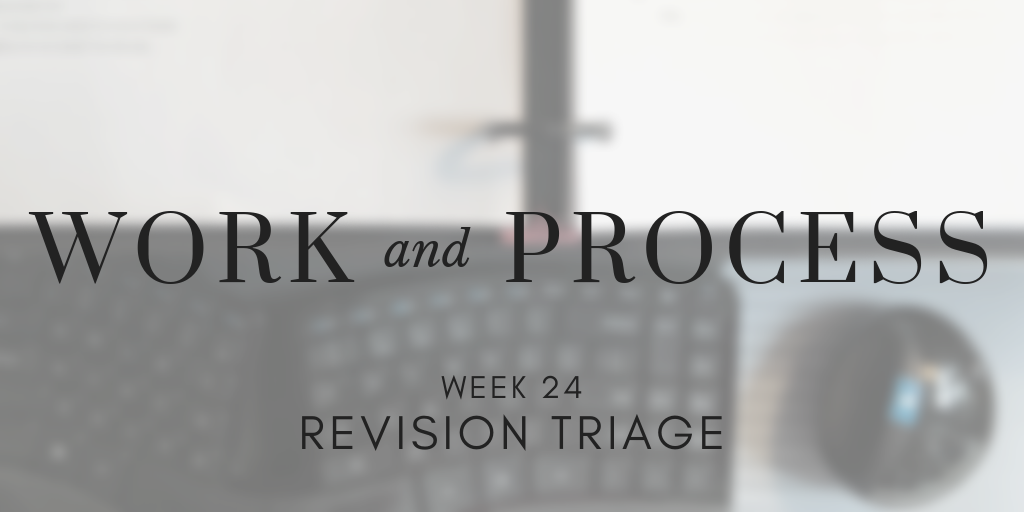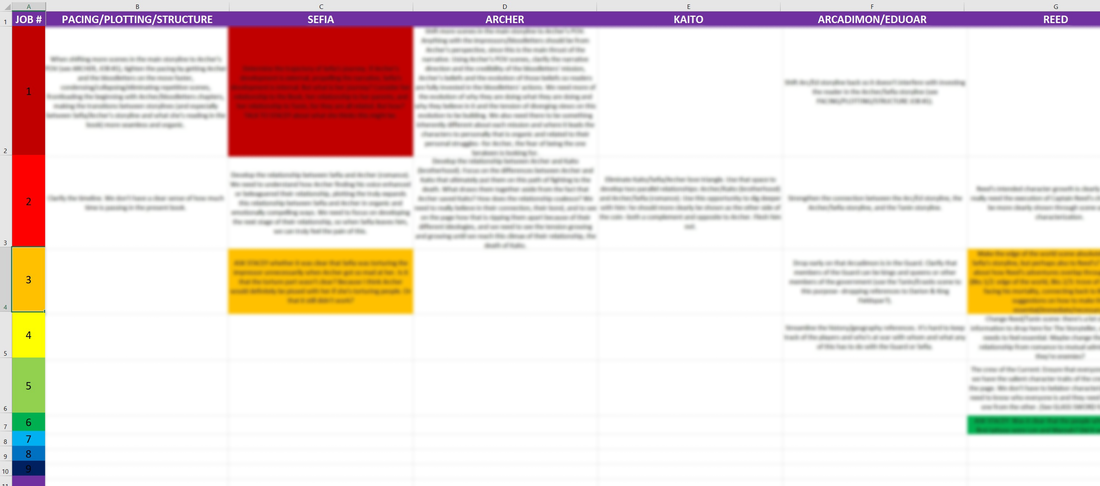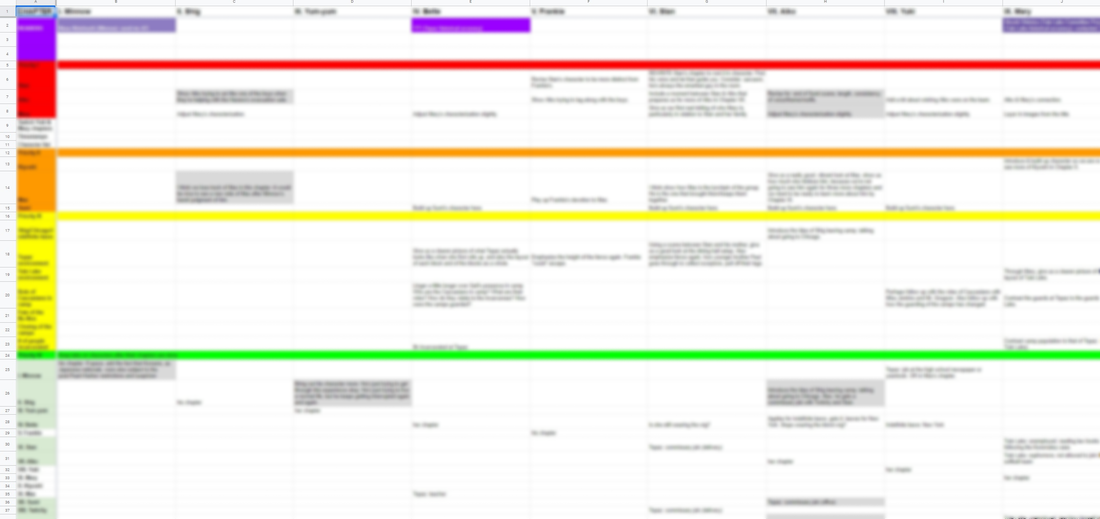|
Over on Instagram, my friend and colleague, Parker Peevyhouse, author of The Echo Room (2018) and Strange Exit (2020), has been posting videos about different aspects of her revision process, and I’ve found it fascinating. (I particularly love this video about the tent pole, which is an approach I’ve never considered before!) I’ve made no secret of my love for revision, and Parker’s videos have inspired me to talk about an aspect of my own revision process: revision triage. To me, revision triage is the process of identifying the varying levels of difficulty in a revision, from the hardest, most time-consuming edits to the easiest, breeziest, just-needs-a-trim-here-or-there alterations, so that when I start revising, I can tackle the biggest and most difficult changes first and gradually move toward the smallest. That process takes a few days to a week, and it usually looks like this: 1. If I have an editorial letter covering the larger patterns and overarching problems of the manuscript as a whole, I’ll read that first (and only once). Edit letters generally point out the biggest issues in a story, so having these on my radar early gives me a way to think about how they all relate to each other and how they might change things in the story once I start tackling them. 2. I’ll set the edit letter aside for 1-3 days, depending on a) what my deadline is and b) how much time it takes me to start having ideas for how to approach the revision. Sometimes I get ideas quickly. Sometimes I have to get ideas quickly because I’ve got to turn my edits in very shortly. But for me, that little window of time is essential for not-doing, for not thinking directly about the work that’s to come so that the ideas from the edit letter can settle and come together in a way that makes sense to my brain. 3. Once 1-3 days have passed, I’ll read the edit letter again, making notes about how to tackle the various issues. This is the beginning of the actual organization process, and it almost always concerns those big, time-consuming edits, so I try to be as clear as I can about how to implement the changes. 4. Then, I’ll read the manuscript from beginning to end, including notes and marginalia from my critique partner(s) or editor. During this read, I’ll STET advice that I already know I won’t be taking, incorporate suggested cuts I know will make the story better, and jot down potential alterations or notes for later. I try to do this quickly, on instinct, using my vision for the story and my thoughts from the edit letter as a guide. I’ll often also write notes at the beginnings or ends of each chapter, summarizing changes that affect the whole chapter instead of just a paragraph or a page, so I can keep track of them later. For me, the purpose of this read is to take in the entire narrative at once, and if I allow myself to linger on one section for too long, I start to lose track of the arc of the whole story, so I try not to take too long with it. I can’t go too quickly, though, because this read of the manuscript also gives me a sense of what the middle-level revisions are going to have to be and what sections need only minor polish. 5. Now, please allow me to introduce you to my extreme Ravenclaw tendencies. Once I have notes from my edit letter and from my review of the manuscript, I go into triage mode. I make a color-coded spreadsheet to group my revisions by the biggest to the smallest, a sort of map for my revisions to come. Above is a revision map for The Reader that I made in 2015. It’s grouped by character (across the top), and then by severity of changes, with the most severe in red and the quickest to address in white. I did a similar map for The Speaker in 2016. As before, I’ve grouped changes by issue and character across the top, but this time I’ve added colors down the side, starting with dark red for the most work and moving toward purple for the least. This map started out much more colorful, but as I went through, I started switching revisions that I had already accomplished to white, which made it easy to track what I’d already accomplished and also what was still to come. This is a revision map for the project I’m currently working on. As before, there are changes by character, but this time I’m also grouping them by different types of changes along the left-hand side. My triage color-scheme is less complicated now, with only five colors: red, orange, yellow, and green, and purple for reminders or other issues. I’m continuing to white revisions I’ve already completed, but this time I’m also graying out revisions that I want to put a pin in for next time. Every revision triage results in a slightly different revision map. People say each book teaches you how to write it, and I've found that to be true of revising as well as for drafting. Each story needs to be told in a different way. Each round of edits has different requirements. But for me, this process always boils down to the color-coded spreadsheet, the categorization of different types of changes. That's what gets me through. Sometimes it feels like this process of revision triage takes too much time, especially when I’m on deadline, but ultimately, it’s so helpful to me to have an overall sense of where the story is headed, what it’s going to look like when all the threads are tightened and all the extra stuff is cut. It helps me to prioritize issues that will create ripple effects in the narrative, so I change things once instead of over and over again if I try to tackle a bunch of little things first. And finally, it makes me feel like I’m moving forward, breaking down even the big tasks into smaller parts, so I can cross them off like little victories in the long slog of revising a novel. Work and Process is a year-long journey of exploring and reflecting on the artistic process, craft, and working in a creative field. Each Sunday, I’ll post some thoughts, wonderings, explanations, and explorations on writing and creativity, and by the end of it, I hope to have 52 musings, examinations, meanderings, discoveries, bits of joy or inquisitiveness or knowledge to share. In each post, I’ll also include a topic for the following week, so if you happen to be inspired to question/wonder at/consider your own work and process, you’re welcome to join me. We’ll be using the #workandprocess hashtag across all social media platforms, and I hope we find each other to learn and connect and transform on our creative wanderings. Comments are closed.
|
ARCHIVES
February 2024
CATEGORIES |





 RSS Feed
RSS Feed